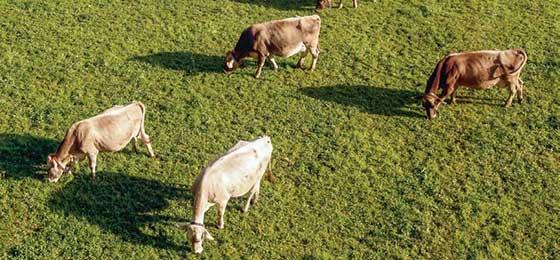The green, green grass of home

Plant growers brought about the so-called green revolution by creating more productive varieties of wheat, maize and rice. Will this revolution soon be reaching the grass on our meadows and pastures? By Ori Schipper
The grass might be greener on the other side, but otherwise people don't pay much attention to how it grows. And yet some two thirds of Switzerland's agricultural land comprises meadows and pastures. So at least in economic terms, grass growth is a factor that we have to bear in mind, and that should be optimised where possible.
Just under a fifth of our grasslands is made up of so-called artificial pasture. Unlike permanent pasture, this is integrated into arable crop rotation and is regularly seeded with forage grass. The seeds of the most important varieties of grass are subject to constant development through cultivation. But whereas our success in cultivating varieties of grain such as wheat, maize or rice has led to spectacular increases in yield and entered into the public consciousness as the 'green revolution', little attention has been paid to the progress made in cultivating forage grasses.
Yet surely forage grass would respond to the same factors that increase the yield of grain crops. The main role is played by so-called hybrid cultivation, though we are still only beginning to understand why hybrid plants grow better and stronger than non-hybrids. Scientists speak of the 'heterosis effect'.
Genes discovered against inbreeding grasses
Bruno Studer is an SNSF Professor at the Institute of Agricultural Sciences at ETH Zurich. He too can only speculate as to what causes this effect. Hybrids are descended from genetically different parents. This is why they display a maximum degree of different gene variants. "This gives them much plasticity, meaning they can adapt optimally to many different environmental conditions", he suggests.
Studer and his team have recently taken a big step towards cultivating hybrid forage grasses. They have found a gene that ensures that the pollen of so-called self-incompatible grasses does not form any pollen tubes when it lands on the stigma of a female flower of the same plant. This gene, called the S-locus gene, is an important component of a biological mechanism that hinders self-fertilisation, thereby preventing inbreeding.
For his work on self-incompatibility, Studer was awarded the Wricke Prize at this year's conference of the German Society for Plant Breeding. The discovery of the S-locus in English rye-grass (Lolium perenne) marks a milestone in the cultivation of forage grasses. "Only with this knowledge can we take cultivation concepts that were imagined decades ago, and implement them in the real world", says Studer.
In his mind, one possibility is to use genetic markers to inform the growers of which plants can be crossed with each other. "If we can steer pollination within breeding populations, then we can use the heterosis effect to increase the yield of forage grasses significantly – but by natural means, and without losing any genetic diversity".
Beat Reidy, a fodder crop expert at the School of Agricultural, Forest and Food Sciences in Zollikofen, also sees great potential in this new finding. However, he believes that only the coming decades will show whether the hoped-for progress has been realised.
Ori Schipper is a science editor in Bern.
C. Manzanares et al.: A Gene Encoding a DUF247 Domain Protein Cosegregates with the S Self-Incompatibility Locus in Perennial Ryegrass. Molecular Biology and Evolution (2015)